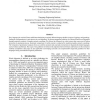Free Online Productivity Tools
i2Speak
i2Symbol
i2OCR
iTex2Img
iWeb2Print
iWeb2Shot
i2Type
iPdf2Split
iPdf2Merge
i2Bopomofo
i2Arabic
i2Style
i2Image
i2PDF
iLatex2Rtf
Sci2ools
LREC
2008
2008
Annotation Guidelines for Chinese-Korean Word Alignment
For a language pair such as Chinese and Korean that belong to entirely different language families in terms of typology and genealogy, finding the correspondences is quite obscure in word alignment. We present annotation guidelines for Chinese-Korean word alignment through contrastive analysis of morpho-syntactic encodings. We discuss the differences in verbal systems that cause most of linking obscurities in annotation process. Systematic comparison of verbal systems is conducted by analyzing morpho-syntactic encodings. The viewpoint of grammatical category allows us to define consistent and systematic instructions for linguistically distant languages such as Chinese and Korean. The scope of our guidelines is limited to the alignment between Chinese and Korean, but the instruction methods exemplified in this paper are also applicable in developing systematic and comprehensible alignment guidelines for other languages having such different linguistic phenomena.
Chinese-Korean Word Alignment | Education | LREC 2008 | Morpho-syntactic Encodings | Word Alignment |
| Added | 29 Oct 2010 |
| Updated | 29 Oct 2010 |
| Type | Conference |
| Year | 2008 |
| Where | LREC |
| Authors | Jinji Li, Dong-Il Kim, Jong-Hyeok Lee |
Comments (0)

